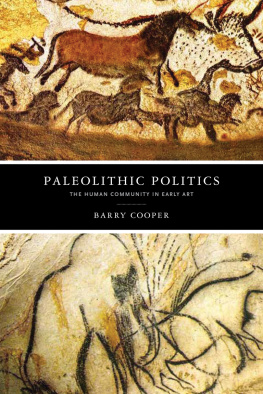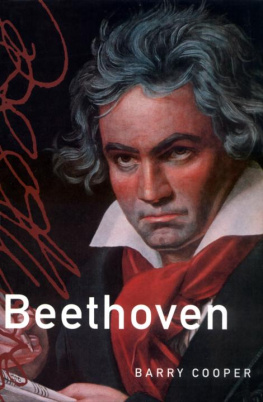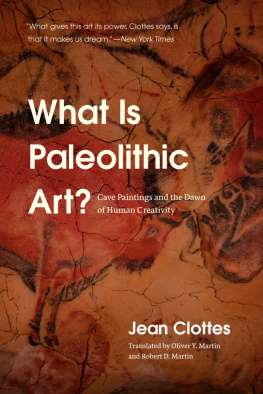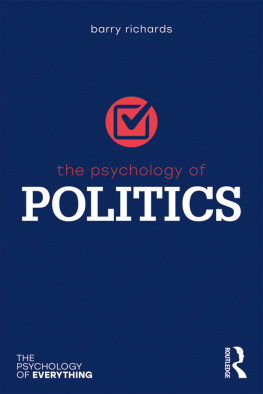Barry Cooper - Paleolithic Politics
Here you can read online Barry Cooper - Paleolithic Politics full text of the book (entire story) in english for free. Download pdf and epub, get meaning, cover and reviews about this ebook. year: 2020, publisher: Lightning Source Inc. (Tier 3), genre: Religion. Description of the work, (preface) as well as reviews are available. Best literature library LitArk.com created for fans of good reading and offers a wide selection of genres:
Romance novel
Science fiction
Adventure
Detective
Science
History
Home and family
Prose
Art
Politics
Computer
Non-fiction
Religion
Business
Children
Humor
Choose a favorite category and find really read worthwhile books. Enjoy immersion in the world of imagination, feel the emotions of the characters or learn something new for yourself, make an fascinating discovery.
- Book:Paleolithic Politics
- Author:
- Publisher:Lightning Source Inc. (Tier 3)
- Genre:
- Year:2020
- Rating:5 / 5
- Favourites:Add to favourites
- Your mark:
- 100
- 1
- 2
- 3
- 4
- 5
Paleolithic Politics: summary, description and annotation
We offer to read an annotation, description, summary or preface (depends on what the author of the book "Paleolithic Politics" wrote himself). If you haven't found the necessary information about the book — write in the comments, we will try to find it.
Paleolithic Politics — read online for free the complete book (whole text) full work
Below is the text of the book, divided by pages. System saving the place of the last page read, allows you to conveniently read the book "Paleolithic Politics" online for free, without having to search again every time where you left off. Put a bookmark, and you can go to the page where you finished reading at any time.
Font size:
Interval:
Bookmark:
Paleolithic Politics
THE BEGINNING AND THE BEYOND OF POLITICS
Series editors: James R. Stoner and David Walsh
The series is in continuity with the grand tradition of political philosophy that was revitalized by the scholars who, after the Second World War, taught us to return to the past as a means of understanding the present. We are convinced that legal and constitutional issues cannot be addressed without acknowledging the metaphysical dimensions that underpin them. Questions of order arise within a cosmos that invites us to wonder about its beginning and its end, while drawing out the consequences for the way we order our lives together. God and man, world and society are the abiding partners within the community of being in which we find ourselves. Without limiting authors to any particular framework we welcome all who wish to investigate politics in the widest possible horizon.
PALEOLITHIC
POLITICS
The Human Community in Early Art

BARRY COOPER
University of Notre Dame Press
Notre Dame, Indiana
University of Notre Dame Press
Notre Dame, Indiana 46556
Copyright 2020 by the University of Notre Dame
All Rights Reserved
Published in the United States of America
Library of Congress Control Number: 2020932819
ISBN: 978-0-268-10713-0 (Hardback)
ISBN: 978-0-268-10714-7 (Paperback)
ISBN: 978-0-268-10716-1 (WebPDF)
ISBN: 978-0-268-10715-4 (Epub)
This e-Book was converted from the original source file by a third-party vendor. Readers who notice any formatting, textual, or readability issues are encouraged to contact the publisher at
To Brendan
On his own quest
Remember that it is not you who sustain the root; the root sustains you.
Romans 11:18.
Lhomme prhistorique ne nous a laiss que des messages tronqus.
Andr Leroi-Gourhan, Les Religions de la Prhistoire
The reason for Paleolithic mans endeavors to construct his assemblages of symbols was that he had something to express.
Andr Leroi-Gourhan, Treasures of Prehistoric Art
CONTENTS
Appendix. Kants Importance for Voegelins
Philosophical Anthropology
PREFACE
This is the third book I have written that tries to apply insight taken from the political science of Eric Voegelin to a subject matter that he did not discuss. The other two dealt with contemporary terrorism and Canadian politics. Unlike with those subjects, Voegelin was actually interested in Paleolithic political symbols. At one point his interest seemed to be sufficiently robust that his students in Munich speculated on whether he might write a volume zero for Order and History on prehistoric orders of symbolization. Obviously he did not.
Those already familiar with Voegelins philosophy of consciousness, which we discuss briefly in chapter 1, will easily understand what he found so congenial in the approach of Marie Knig, discussed in chapter 2. Her discussion of stone tools and images in Paleolithic art, or of the importance of change within continuity, can be translated without distortion into Voegelins language of compactness and differentiation of experiences and symbolizations.
Until the past few centuries, human beings lived in a world where there were far more animals than humans. It is perhaps not surprising that both portable Paleolithic artifacts and the cave walls were extensively decorated with the images of animals. One of the conclusions of this book is that the animal imagery expressed a differentiation of human and animal consciousness within the continuity of human and animal being. These very early symbols were both immediate and simple. Such reflective distance (to use a later term of Voegelin) as existed would have been expressed in stories and myths illustrated by the animal images. Following Voegelins argument, discussed in chapter 1, we would call these stories cosmological myths. The details of such stories are, however, irretrievably gone, and we are left to consider what has been called the material fragments of the practical expression of Paleolithic politics/religion/cosmology if we but have the wit to interpret them. Whether such an observation could apply to the signs also found in Paleolithic caves depends on how such phenomena are understood. At present the signs are highly understudied and, partly for that reason, their interpretation is controversial. In this book we say very little about the signs.
Knig also argued that the earliest and most compact symbolic forms were also the most universal, immediate, and directly apprehended. For this reason, they may have been the most arresting in terms of spiritual potency. Later symbolism, Voegelin argued, was both more differentiated and specific and thus was more accurate, in the sense that it provided a more nuanced and adequate representation of reality. This did not mean that later, more differentiated symbolisms added to the stock of human knowledge in the sense of providing additional information about reality. The very notion of differentiation for Voegelin presupposed the presence of reality in a compact and comparatively inarticulate form. Differentiation simply brought to consciousness what was already present and inchoately known.
Voegelin discussed this process of differentiation within reality many times, especially in his later work. A particularly apt formulation regarding the problems associated with very early symbolism is found in the introduction to volume 4 of Order and History. Here Voegelin raised the question of why, despite the existence of more differentiated symbolism, the compact cosmological symbolism meaningfully persisted: This peculiar structure in history originates in the stratification of mans consciousness through the process of differentiation. The truth of existence discovered by the prophets of Israel and the philosophers of Hellas, though it appears later in time than the truth of the cosmos, cannot simply replace it, because the new insights, while indirectly affecting the image of reality as a whole, pertain directly only to mans consciousness of his existential tension [toward the divine ground of being]. In conventional language, one would speak of the revelation of the hidden god beyond or transcendent to the intracosmic gods. Voegelins emphasis, however, was on the visionary or auditory or meditative experience of the individual who responded to this divine presence. More precisely, the individual discovered that his human consciousness was somehow also the site where divine presence was experienced. Such an individual participated in a theophanic event, and his or her consciousness became cognitively luminous for his own humanity as constituted by his relation to the unknown god whose moving presence in his soul evokes the movement of response. I have circumscribed the structure of the event as strictly as possible, in order to make it clear how narrowly confined the area of the resulting insights actually is: The new truth pertains to mans consciousness of his humanity in participatory tension toward the divine ground, and to no reality beyond this restricted area. That restricted area referred only to the immediate experience in the consciousness of the individual who responded to the theophany, thus making it an event, which is to say, if no human response, then no event.
Of course, the human beings who underwent such experiences sometimes did not acknowledge the narrow or restricted area of reality involved, namely, their own human consciousness in tension towards the divine Ground of Being. More specifically, the differentiation of existential truth does not abolish the cosmos in which the event occurs. Regarding its existence and structure, however, the cosmos is experienced as divinely created and ordered. The new truth can affect the belief in intracosmic divinities as the most adequate symbolization of cosmic-divine reality, but it cannot affect the experience of divine reality as the creative and ordering force in the cosmos. That is, because the differentiation of consciousness occurred within the cosmos, the need to symbolize the reality of the cosmos did not disappear. What Voegelin called the primary experience of the cosmos and the earliest symbolization of it were never superseded by the later forms, including revelation and philosophy. In one sense this was self-evident: the earliest symbolic forms constituted the context or background in light of which all subsequent differentiations took place. If later symbolizations were in some sense an advance, this did not abolish the need to understand what they have advanced from.
Font size:
Interval:
Bookmark:
Similar books «Paleolithic Politics»
Look at similar books to Paleolithic Politics. We have selected literature similar in name and meaning in the hope of providing readers with more options to find new, interesting, not yet read works.
Discussion, reviews of the book Paleolithic Politics and just readers' own opinions. Leave your comments, write what you think about the work, its meaning or the main characters. Specify what exactly you liked and what you didn't like, and why you think so.













